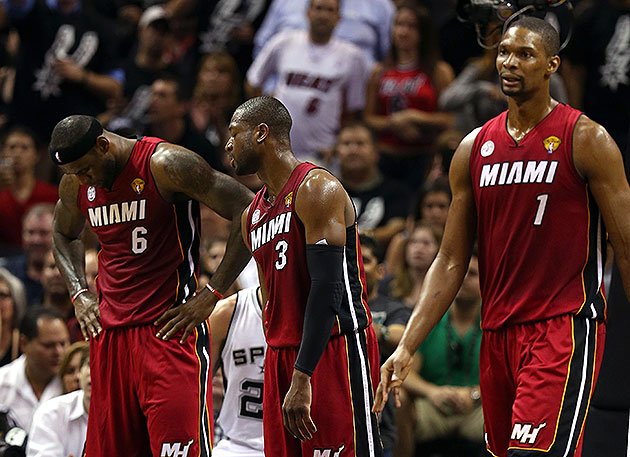
After Game 1 of the 2013 NBA Finals, the big question was, "Can you believe Tony Parker hit that?" After Game 2, the big question was, "How the hell do you stop the Miami Heat when they play like that?" After Game 3, it was, "How the hell do you beat the San Antonio Spurs when they shoot like that?"
We don't yet know what the main topic of conversation will be after Thursday's Game 4, but we do know what some of the big questions are heading into this critical matchup. By night's end, we'll either have a knotted-up best-of-three NBA Finals or a Spurs team locked into a commanding 3-1 lead and within 48 minutes of the fifth NBA title of the Gregg Popovich-Tim Duncan era. Walk with me a bit as we run down seven big questions rattling around my brain today:
1. Can the Heat continue their five-month-long streak of winning after a loss?
Kind of a big one, right? You've likely already heard or read this note, but it's worth mentioning again: The Heat haven't lost back-to-back games since dropping two straight to the Indiana Pacers and Portland Trail Blazers on Jan. 8 and Jan. 10. And the Heat haven't just avoided losing streaks — they've been dominant in doing so.
Game 4 will mark the 12th time since Jan. 10 that the Heat have entered a game coming off a loss. They've won the previous 11 by an average of 19.8 points per game. The margin's risen to 21.6 following Miami's five postseason losses, including a 19-point win in Game 2 on Sunday after dropping the opening contest of the Finals.
There are obviously plenty of things that go into a stat like that — changes in opposition during the regular season, in-series adjustments in the playoffs, etc. — but if nothing else, Miami's shown an ability to bounce back after bad beats without carrying too much of the sour momentum forward with them, which could serve them in good stead on Thursday.
"We've been at our best when I guess our backs are up against the wall, and we're at it again," LeBron James said Wednesday. "We'll see how we respond tomorrow."
2. What will the "better" LeBron look like, and how will the Spurs address it?
A big part of that response, obviously, hinges on whether or not James can break through a Spurs defense that has been brilliant at stifling him throughout most of the series' first three games.
"They're doing a great job of putting bodies in front of me and not allowing me to have some of the creases I have had throughout the playoffs," James said. "Some of it is me being out of rhythm. It's a little bit of both."
Really, it's been a lot of both, as a Spurs defensive attack led by primary on-ball defender Kawhi Leonard, secondary on-ball defender Danny Green and a well-drilled, focused group behind them has sagged far off James in the half-court, showing him that he's going to get swarmed if he drives and aiming to keep him on the perimeter. And while James has put in a ton of work to improve his jumper over the past couple of seasons, you'd clearly much rather have James firing outside-the-paint shots he hit at about a 42 percent clip this year than getting into the restricted area, where he made three-quarters of his tries during the regular season.
The strategy's paid off brilliantly for San Antonio, as James has taken just 15 shots at the rim (about 2 1/2 fewer per game than he managed during the season) and 39 shots outside the restricted area (about 2 1/2 more per game than during the season) through three Finals games. Even better, the four-time MVP's had scarcely any touch on anything fired from further than a couple of feet out, shooting just 23.7 percent on attempts outside the restricted area.
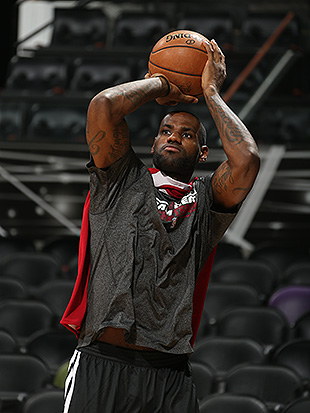 Heat coach Erik Spoelstra said he hasn't seen anything on tape that indicates a hitch in James' jumper or something mechanically unsound in his star's approach, which has led some to wonder whether the issue lies between James' ears. He's not trying to hear that.
Heat coach Erik Spoelstra said he hasn't seen anything on tape that indicates a hitch in James' jumper or something mechanically unsound in his star's approach, which has led some to wonder whether the issue lies between James' ears. He's not trying to hear that.
"Mentally, it's not a problem. Mentally, I'm not out of it, saying that my shot is gone," James said. "I know what I can do. It's just about going up there and knocking them down. I will do that."
While Spoelstra ("No, it's not all on him — it's all of us") and teammate Ray Allen ("First and foremost, he has to allow us to help him — he can't feel he always has to take so much of the burden on himself") disagree with the notion that James has to, or should, take full responsibility for Game 3, James understands as much as anyone the way superstars are judged and the disproportionate burden of stardom.
"I have all the confidence in the world in my teammates. But I am the star, I am the leader, and they look at me to do things on the court, to make plays," he said. "And if I'm not doing it, I'm not doing my job."
So he's vowed to be "better" in Game 4, with much of the focus trained on how a jumper-reliant James has managed just six free-throw attempts in three games, including a big fat zero in Game 3. Like just about everyone else in the free world, LeBron finds this unacceptable.
"I mean, 7 for 21 isn't going to cut it. Zero free throws," James said. "I had 11 rebounds, I had 5 assists, but 7 for 21 and zero free throws ain't going to cut it [...] You have to figure out ways offensively that you can make an impact."
One would assume, then, that James would look for more opportunities to drive to the basket against the San Antonio defense and seek contact in the paint, which could make the game management of referees Scott Foster, Mike Callahan and Bill Kennedy a key element of Game 4. (Here's hoping not, though.)
3. So how can the Heat get LeBron attacking more often?
For one thing, he can start by trying to take advantage of San Antonio switches/cross-matches that result in him singled up on the likes of Tim Duncan or Tiago Splitter up top. He's drawn those matchups multiple times in this series and too often settled for jumpers rather than trying to take the Spurs' bigs off the bounce, which in context makes sense (don't drive into a thicket of defenders' arms, do take a shot that your teammates have a better chance of rebounding without a big inside) but also reduces the likelihood of him drawing a foul on the drive or getting to a rim unprotected by a shot-blocker. Ditto for post touches — Leonard and Green have been better against James on the block than many suspected thus far, but the sheer number of ways James can dismantle a defense from the post would seem to demand more opportunities there.
What else? On Wednesday, James mentioned pushing the ball off defensive rebounds, "where I'm getting the ball off the backboard and trying to create some early offense instead of playing against their half‑court defense." He also seemed to like one reporter's suggestion of receiving the ball on the move rather than operating in a static screen-and-roll attack where the Spurs defense can load up and key in on him.
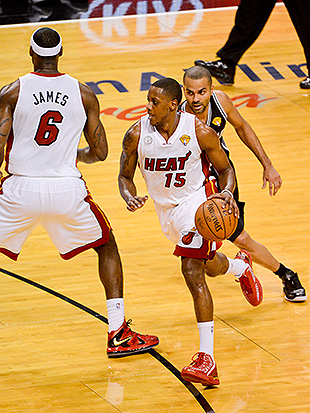 On that last score, it'll be interesting to see if Spoelstra decides to take another look at the pick-and-roll with with Miami had such success in Game 2, as James and point guard Mario Chalmers sliced and diced the Spurs defense to key their huge second-half run. The Heat didn't go to it very much in Game 3 and were unsuccessful when they did, generating no field-goal attempts and three turnovers in the Chalmers-James screen game.
On that last score, it'll be interesting to see if Spoelstra decides to take another look at the pick-and-roll with with Miami had such success in Game 2, as James and point guard Mario Chalmers sliced and diced the Spurs defense to key their huge second-half run. The Heat didn't go to it very much in Game 3 and were unsuccessful when they did, generating no field-goal attempts and three turnovers in the Chalmers-James screen game.
Miami did, however, get some good looks when James ran it with Cole early in the game, with the backup hitting a short jumper, LeBron creating a baseline dive and dunk for Chris Andersen, and Cole getting a layup that missed but generated an offensive rebounding opportunity on successive trips in the first quarter. They largely went away from it, however, after Leonard used his long arms and strong hands to steal an attempted Cole feed to a rolling James on the first play of the second quarter — but an eventual return to the action netted James an open 3-pointer.
So why did it work with Cole and not with Chalmers? Well, for one thing, Chalmers seemed to have an awful time finding any sort of rhythm or pace in Game 3, following up his fantastic Game 2 performance with an 0-for-5, four-turnover, four-foul clunker. For another, though, the successful Chalmers-James pick-and-rolls from Game 2 came with the duo sharing the floor with floor-spacers Allen and Mike Miller, who forced the Spurs' wings to stay connected to them defensively (opening up those "creases" for Chalmers and James) or pay the price via the long ball.
All three times they tried it in Game 3, though, they ran it with Dwyane Wade on the floor, and — as I've written — Wade's been awful shooting from anywhere outside the restricted area. This gives the Spurs defending Wade (mostly Green and Manu Ginobili) a license to sag even further off him than San Antonio's been sagging off James, which all but eliminates any of the space Chalmers or James might be able to use to either pull up or attack the rack after the screen:
So maybe the issue was less that San Antonio solved the problem Miami posed in Game 2, and more that the Heat didn't ask the right question of the Spurs' defense in Game 3.
The total lack of respect that the Spurs are showing for Wade on the perimeter leads me to another question ...
4. Will Spoelstra curb Wade's minutes?
Anyone who's been watching Wade play for the past three months can plainly see that he's been significantly hampered by his right knee injury, as the All-NBA Third Team guard has shown precious little of the burst, lateral quickness, open-court explosion or general havoc-wreaking that helped him to arguably the most efficient offensive season of his career this year. There's not necessarily a doubt that Wade's giving Spoelstra what he has to offer (on the offensive end, at least) for as much as he can; rather, the issue might be that the tank just doesn't hold as much gas as it used to, thanks to the knee injury.
Wade has scored in double figures in the first halves of all three games in this series, totaling 35 points on 15 for 25 shooting with 11 assists against three turnovers in 54 minutes. After intermission, though, he's fallen off a cliff — just eight total points on 4 for 18 combined shooting, two assists and two turnovers in 45 minutes. Wade was asked about the stark drop-off on Wednesday, and whether it's connected to ongoing knee trouble that reduces his effectiveness throughout the game.
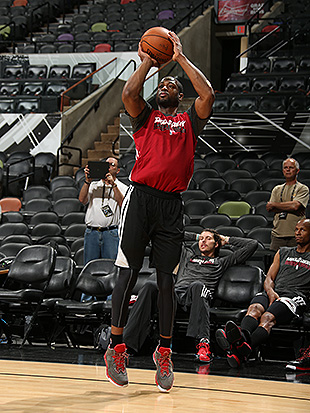 "If it is, I won't tell you yes," Wade said. "So that's a pointless question."
"If it is, I won't tell you yes," Wade said. "So that's a pointless question."
It might not be so pointless, though, to ask whether this version of the Heat, right now, can do more with less Wade. Tom Haberstroh suggested as much in a recent ESPN Insider piece on the prospect of benching Wade. Miami has outscored its opposition by 5.1 points per 100 possessions with Wade on the bench this postseason and by 15.3-per-100 with Wade sitting down.
The stats suggest that Miami's been WAY worse with Wade on the court through three Finals games (San Antonio's blowing them out nearly 18 points-per-100) than with him sitting (the Heat have blown the Spurs out by more than 22 points-per-100), too. And while the small sample size makes the numbers hard to rely on, that seems to match the eye test, which reveals how San Antonio's not worrying about him, how he's fading later in games and even how the Heat seem to be both more defensively active and attentive when Wade leaves in favor of Allen.
Wade, like James and Chris Bosh before him, swears that while he's taking what San Antonio's defense gives him, he feels good abou the looks he's getting.
"Obviously, on my pick‑and‑rolls, they go under, and that's pretty much it. Limiting my opportunities. I shoot some, some I don't. Some I get in the paint, and try to make plays," Wade said Wednesday. "I got some shots in the second half that I liked. I just missed them. I think out of my 15 shots, 14 of them I would love to take every time. I thought one of them I rushed. But the rest was good shots."
"Good" in the sense that open shots are better than contested ones, sure. But when bad jump-shooters take lots of jump shots, that's not good for an offense, especially when there's an elite jump-shooter who might be a better option and, thanks to the cruel mistress of injury, isn't nearly as big a defensive downgrade from Wade as he once seemed.
It'll be interesting to see if the rumored insertion of Miller into the starting lineup for Udonis Haslem — which would represent a full-on embrace by Spoelstra of small-ball and spacing as the way for Miami to get back into things — would mitigate some of the negatives of Wade's minutes on both ends of the court. Thus far, as Heat.com's Couper Moorhead notes, the Heat have performed quite well when Miller and Wade have shared the floor this postseason.
If adding another shooter to open up the paint can create more driving and cutting lanes for Wade, and Wade remains persistent in taking advantage of those lanes, then maybe he could have a larger impact longer in Game 4. It could be a way to gain some of the positives of benching Wade (better floor spacing, more versatile and attentive wing defense) without actually sitting him down.
It'll also be interesting to see how trading big for small in the starting lineup would impact the next question ...
5. Can the Spurs keep pounding the Heat on the offensive boards?
As I wrote before the Heat's second-round matchup with the Chicago Bulls, Miami was one of the NBA's worst teams at clearing the defensive glass and preventing second-chance points this season. The Pacers' rugged frontcourt of Roy Hibbert and David West did a masterful job of exploiting that weakness in the Eastern Conference finals, even when Miami eschewed its preferred small-ball style in favor of more conventional two-big lineups featuring Bosh alongside Haslem, the Birdman and Joel Anthony.
A San Antonio team that Popovich prefers to drop back in transition rather than crash the offensive glass wasn't supposed to have the same sort of success in the Finals. And yet, the Spurs — who took in the league's second-lowest share of their own misses and finished 29th out of 30 NBA teams in second-chance points per game — have dominated the offensive glass, grabbing 30.5 percent of available offensive rebounds, which would've ranked fourth in the NBA this season.
Considering San Antonio was shooting just 42.4 percent from the floor before the second half of Game 3, those possession-extending boards — which they've turned into 18.7 second-chance points per game, blowing away their regular-season mark (10.1) and topping what the league-leading Denver Nuggets managed (15.8) — have been huge both for buoying their own offense and preventing Miami from jumpstarting their own by getting out in transition and getting easy buckets.
The key to keeping the Spurs off the offensive boards, as Bosh sees it?
"Go get the damn ball," he said. "That's about it."
Wade was a bit more specific.
"We have to box out, we have to jump, we got to get them — we just got to do more," Wade said. "We have to get stops where we got to rebound the ball [...] When we're getting stops, they're getting offensive rebounds. That can't happen. It starts there."
And that needs to start with increased attention to detail by Miami, because Leonard and Duncan (13 offensive rebounds each in three games) have had a field day taking advantage of unfocused Heat rebounders.
Time and again through the first three games, Leonard just streaked past a Miami wing without so much as being contacted after a shot's gone up; James said Wednesday that he's sometimes being victimized by Leonard while dropping down into the paint to help out his bigs, but in a lot of those situations, LeBron's just not making much of an effort to find Leonard and put a body on him, as was the case on this third-quarter play, which itself followed a Duncan offensive rebound of a missed Danny Green 3-pointer:
Duncan's been opportunistic, finding caroms after Miami interior defenders have rotated to cut off penetration. The Heat's help rotations must be crisper, their awareness must be heightened and their decisions must be made quickly, unlike what happened after this Gary Neal floater late in the second quarter of Game 3:
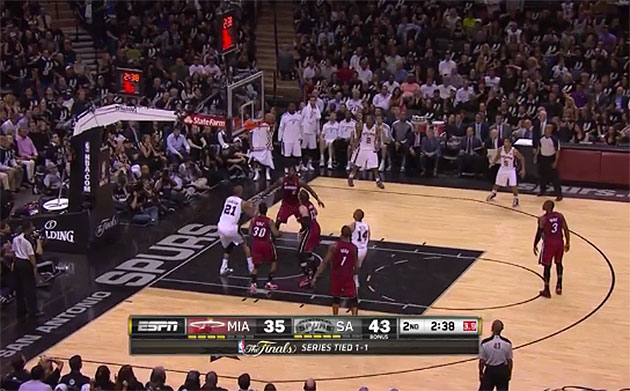
James, Miller and Cole were all within about two feet of the basket. They're all waiting to see what happens. Duncan isn't, and he gets two extra cracks at the basket. He misses both, taking a finger in the eye on the second attempt, but still: Go get the damn ball, Miami.
6. Can San Antonio continue to force the Heat to switch on defense, and will the Heat be better prepared to manage those switches without giving up the store?
Miller said Wednesday that the Heat are "not accustomed to switching as much" as they did in Game 3, and the confusion — and lack of communication — led to some glaring and troubling breakdowns, as broken down by Beckley Mason for the New York Times:
On a play that ended with Green’s 3-pointer from the corner, Neal pushed the ball upcourt off a rebound and received an early ball screen from Matt Bonner. The Heat defenders switched, leaving forward Shane Battier on Neal. Battier appeared to have the play bottled up, but as Neal drove, Dwyane Wade needlessly left Green to help on defense, giving Neal an obvious outlet pass and Green an easy make from the corner.
Later, an obvious mix-up between LeBron James and Mike Miller resulted in both players chasing Manu Ginobili around the perimeter as Neal, a deadeye shooter, wandered up to the 3-point line. By the time the Heat defenders sorted out their responsibilities with Ginobili, Neal had the ball and was rising to nail the shot.
This kind of stuff happened a lot on Tuesday, with Miami defenders often seeming unsure which Spur they were supposed to pick up until it was too late. And it gets too late quickly, as Bosh noted, when you're playing against a team that makes quick decisions and crisp passes.
"Our initial mistakes caused us to chase them," Bosh said. "It's like guarding us — if you make one mistake, the minute that first domino falls, the rest come."
The good news for the Heat is that they've shown a capacity to not only stay with the Spurs' offense, but to force it into mistakes — remember how well they snuffed out San Antonio's pick-and-roll attack in the second half of Game 2. Even if Miami can't once again achieve total lockdown like it did during that stretch, Spoelstra's team must be able to clean up the communication issues, avoid the initial mental errors that trigger bigger back-end issues to be exploited by ball movement, and remain aggressive in the face of a San Antonio team that will have Tony Parker, but might need to rely more heavily on the likes of Cory Joseph, Ginobili and Neal to facilitate offense if the starting point guard's strained hamstring tightens up.
If Miami can keep that first domino from falling more often than not, they should put themselves in position to create more contested shots, more defensive rebounds and, ideally, more transition offense that can help loosen up every member of the Heat's offensive game.
"In order for everybody to play well, not only LeBron, we have to play better defense team‑wise, and we have to look for opportunities to get easy shots," Bosh said. "We can't do that if we're constantly taking the ball out the net."
Which brings me to my last question ...
7. Can Danny Green really keep shooting like this?
America might not have known how good a shooter Green has become before Tuesday night, but he's finished in the top 10 in the NBA in 3-point accuracy in each of the last two years, he's got the fourth-highest career long-ball percentage among active NBA players, and he was 28 for 65 (43.1 percent) from deep in the postseason heading into the Finals. That stroke's legit.
That said, here's a bold prediction: I don't think the sharpshooting UNC product will continue to hit 69.6 percent from downtown for the balance of this series. But as my colleague Eric Freeman wrote of the Spurs recapping San Antonio's epic 16 3-pointer performance in Game 3, Green's marksmanship is "no mirage."
If Miami wants to keep Green from lighting them up all day, they're going to have to avoid sloppy rotations, close out under control, get hands in his face and keep him from being able to calmly step into shots like there's no defense in front of him, even when there is one. Unconscious shooters need to be woken up, and it'll be critical for Miami to shake Green out of his sweet slumber in Game 4.
No comments:
Post a Comment